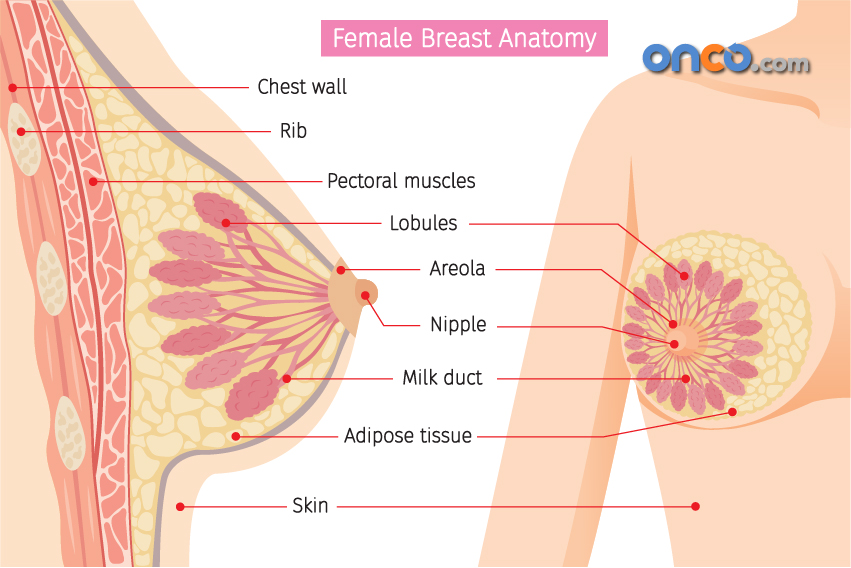Breast cancer occurs when cells in the breast tissue mutate and rapidly divide. These abnormal cells form a tumor. A tumor can become cancerous when these abnormally growing cells spread to other parts of the breast or the body. Metastasis is the process of abnormal cells dividing. Metastasis happens via the bloodstream or the lymphatic system that helps fight infections.
It generally begins in the milk-producing glands (lobules), or in the tube-shaped ducts that carry milk from the lobules to the nipple. Sometimes, it begins taking shape in the fatty and fibrous connective tissue of the breasts.
Both women and men are at risk of developing a tumor in the breast. But it is 100 times more common in women than in men. It is one of the leading causes of cancer-related deaths in women around the world. But the mortality rates have declined in recent years. Better awareness, regular screening, and advanced treatment options have proved useful. 
Get the right diagnosis and advice
How does breast cancer occur?
Tumor in the breast begins with a genetic mutation in the DNA of breast cancer cells. Some of these mutations may develop randomly over time. Naturally, the human body to constantly mutate and fix itself. When there is an inhibitio in the body’s ability to mutate itself, a tumor occurs. Some mutations are hereditary while others are sporadic. Read on to find out the causes.
Causes
Risks due to genetic predisposition
- Being a woman
- Being an older woman
- Family history
- Personal history of having breast cancer
- Genetic abnormalities
- Race and ethnicity
- History of menstrual activity
- Dense breasts
Risks due to lifestyle habits and environmental exposure
- Lack of physical activity
- Being overweight or being obese
- Alcohol consumption
- Smoking
- Exposure to radiation (before the age of 30)
- Pregnancy timelines
- Breastfeeding history
- History of hormone replacement therapy (HRT)
Signs and symptoms
It is important to keep track of your breast health and pay attention to unusual symptoms that may persist.
- Variations in the size and structure of the nipple
- Permanent breast stains
- Persistent lumps
- Nipple discharges in the form of yellowish, brown, and red liquid
- Persistent swelling underneath the collarbone or even under the arm
- Breast redness that is not usual
- Skin irritation and itchiness
Screening and diagnosis
International guidelines recommend regular examination for women more than 50 years of age. Screening tests include:
- Screening mammogram: A mammogram is an X-ray of the breast. Upon confirmation of tumor cells, doctors recommend a diagnostic mammogram.
- Clinical examination: An examination for breast lumps and around the chest and underarms
- Breast MRI: Doctors recommend an MRI for women with high-risk genes (BRCA 1/2).
Further diagnostic tests include:
- Diagnostic mammogram: Particularly for diagnostic purposes, advanced mammography uses X-rays and compression plates to check for abnormalities in the breasts.
- Breast ultrasonography (USG): Images tumor cells through sound waves.
- Biopsy: A gold standard test for cancer diagnosis, the process involves extorting tumor tissues using a needle. Specialists then examine the tissues under a microscope in a laboratory.
Treatment Options
- Surgery
This form of treatment involves mastectomy i.e. complete removal of the breast or lumpectomy i.e. tumor removal within margins. The latter is also termed as surgery for breast conservation.
- Radiotherapy
This breast cancer treatment involves the usage of intense radiation for killing off cancerous cells. In most cases, radiotherapy is a follow-up treatment after successful mastectomy.
- Chemotherapy
This form of treatment involves the usage of intravenous medication administration for killing off cancerous cells.
- Hormonal Therapy
An extremely focused treatment variant for the hormone receptors that are either ER or PR positive. However, the final hormone choice depends on our menopausal status.
- Targeted Therapy
This is a cancer treatment strategy that involves targeting specific proteins and genes, located within the cancerous region of an existing tumor.
Breast Cancer Stages
Accurate breast cancer stages provide data about the following:
- The size of the tumor
- The invasive nature of the tumor
- If the tumor has reached the lymph nodes
- Metastasis
- If the cancer is a relapse
Depending on the above factors, the tumor in the breast stages from 0 to 4. Staging helps doctors layout an optimum treatment plan to follow through.
Stage 0 – Also called in situ breast cancer – The cancer cells are only in the duct or lobule where they started and have not grown into nearby breast tissue (non-invasive).
Early-stage breast cancer – The tumor is smaller than 5 cm and cancer has not spread to more than 3 lymph nodes. It includes stages 1A, 1B and 2A.
Locally advanced breast cancer – The tumor is larger than 5 cm. Cancer may have spread to the skin, the muscles of the chest wall or more than 3 lymph nodes. It includes stages 2B, 3A, 3B and 3C. Inflammatory breast cancer, also called locally advanced breast cancer, is a type of metastatic cancer.
Metastatic breast cancer – cancer has spread to other parts of the body. It is in stage 4.
Survival Rates
Generally, relative survival rates help accurately study and estimate the real effect of cancer on survival. These relative survival rates compare the longevity of women with breast cancer, to women across the general population. A 90% survival rate means that patients are 90% as likely to live for the next five years compared to people who do not have that cancer.


